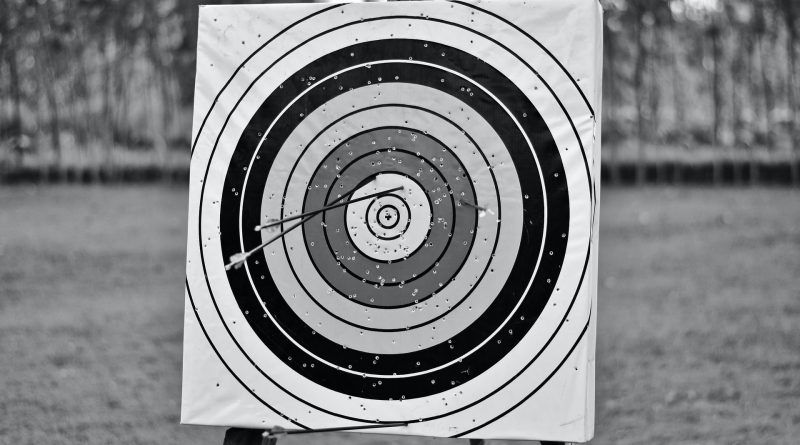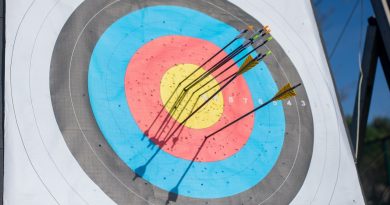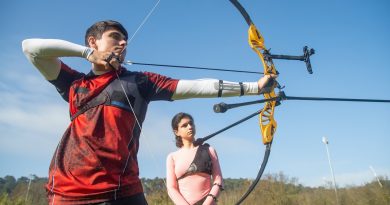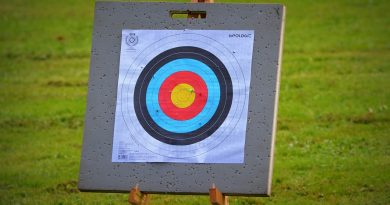Moving Targets
The first goal of the steadily increasing number of bow hunters is understandingly the urge to hit a fixed target. The novice concentrates on acquiring the necessary technique by shooting at a mark from a fixed distance, and the measure of his progress is the gradual decrease in the diameter of the circle which will contain the group of arrows he has shot at the target.
Whether an archer elects to use a sight on his bow or shoot without one, he is tied to a fixed target at a known distance until he can hit a mark consistently. Only when this stage is reached has the archer learned how to shoot his bow. Unfortunately many archers do not progress beyond this stage. They become expert at registering hits on a target at a known distance, and are satisfied to confine the sport within these limitations. The first phase is basic training for all archers and from it we should move naturally to the second stage to increase the pleasure we obtain from participating in the sport of archery. This phase demands of us that we acquire the ability to shoot with the same accuracy at a fixed target when we vary the distance to the target between shots. We have acquired the technique of shooting the bow. Now we want to put it to use under varying conditions.
Unfortunately an attempt has been made to divide archery enthusiasts into two distinct groups labeled “Target” and “Field” archers, and to further limit the field archer to the bowmen who shoot without a sight, or to use an expression commonly heard, “the bowmen who shoot with a bare bow,” and to think of archers who use a mechanical sight on the bow as target archers. Actually, such attempts to limit the bowman in his choice of weapons and accessories are foredoomed to failure. Each of us wants to shoot accurately and that urge will cut across any and all artificial barriers, classifications, and organizations which in the past, and to some extent today, make it difficult for an archer to participate in any shoot held in his locality. On the modern field course, archers in increasing numbers are using a sight on the bow. The practice is not limited to newcomers in the sport. Many of the old time field archers have improved their scoring ability and raised their classification by adapting a mechanical sight to their bow, and many so-called target archers are now seen enjoying themselves at field shoots.
The ultimate aim of many of the new crop of bowmen is to use the bow in pursuit of game, and their practice is directed toward that end. The modern field course and the standard rounds of competition are all based on stationary targets. There is a growing demand among this new crop of archers for an opportunity to shoot at moving targets. This is only partially satisfied by the occasional novelty shoot which may include a swinging and/or a disappearing target. These shoots are held infrequently. Too little importance has been attached to the need to provide a competitive round which will give bowmen frequent practice in shooting at moving targets. Game can not be expected to cooperate with the bowhunter to the extent that it will stand still on all occasions anymore than it can be expected to remain in the vicinity while the archer measures the distance in yards to his quarry and adjusts his sight accordingly.
The concluding phase of our development as bow hunters is to add to our accomplishments the ability to hit a moving target. The bow is a low velocity weapon, and to shoot at a moving target is to insure a miss. The skeet and trap shooters all know that lead is a primary requisite if clay birds are to be broken in flight. Lead, while discussed at length in any gathering of shot gun enthusiasts, is really very little understood, as it can not be readily, visually demonstrated to the gunner. Chapters and books are written on the single topic of lead, but it is extremely difficult for the gun hunter to translate the information into action. Not so with the bowman who observes the flight of his arrow as it travels toward the moving target.Any gunner accustomed to shooting at moving targets, upon observing the flight of an arrow under similar conditions, will almost automatically make the necessary adjustments in his aim or lead to enable him to hit the moving target. In fact he will be delighted with the improvement in his gun handling after he has learned the mechanics of leading from watching his arrows, instead of reading about lead, except to understand the basic principles employed in determining lead.
Lead has three components: 1, the speed of the target; 2, the velocity of the missile; and 3, the distance of the shooter from the target. Of these the second and third can for practical purposes be combined and considered under the general term of distance by considering the velocity of the missile a constant factor.
To compensate for the speed of a moving target on a crossing shot, no guess work is required. Bring the bow to full draw behind the running game and swing the bow in a horizontal arc to match the speed of the target. That takes care of the speed with which the game is moving regardless of its rate, that is, how slow or how fast it is traveling.
Now to compensate for the remaining factors which we have combined and designated as distance factors, or the distance to the target from the shooter. Increase the rate of movement of the bow until it moves across and out in front of the running game, and release the arrow while the bow continues this rate of motion. The point at which the release must be made, and the major problem for both the gunner and the bowman, will quickly be found by the bowman because he can see the flight of his arrow. This is the advantage you have as a bowman over the gunner who cannot see the result when he misses. Since the velocity of the arrow can be considered constant, the distance from the point of release of the arrow, back to the target will increase directly in proportion to the distance the bowman is from the target.
Last but of primary importance is to keep the bow swinging after the arrow is released. Call it the follow through if you wish. Any attempt to stop the bow to release the arrow will nullify your previous actions and cause you to miss the target. You will be surprised, after the first few awkward attempts, that you can register a hit on a moving target with consistent regularity and your bow arm will still be swinging in the same direction the target is moving when the arrow strikes the mark. If you have viewed movie shorts of Howard Hill making crossing shots at moving targets, his follow through is very conspicuous, giving the appearance that he is waving his bow at some person in the distance.To hunt successfully with the broadhead arrow, they should be used in practice. Due to the longer shaft, the bowman, who uses an imaginary aiming point on which he superimposes the tip of the arrow, will need to find a new aiming point to secure the proper elevation in the flight of the arrow. Provided the arrows are matched in weight and spine, the sight shooter does not need to make any adjustments in changing from one type of pyle to the other.
The penetration of the broadhead makes it very difficult to withdraw them from most targets. Neither is a target area through which the arrows pass freely a satisfactory solution. The urge to mark the position where the arrow lands, will result in transferring the attention and the vision from the aiming point and cause a miss at the last phase of the act of shooting. To prepare a target from which the broadheads may be withdrawn freely, construct a wooden frame of inch boards about eighteen inches in height and approximately thirty inches in width. Rig the frame with two V belt pulleys so that it will run on a wire. Install the pulleys on the back of the frame so that they are not visible from the shooting line to prevent damage to your broadheads. Cover the front of the target with approximately two inches of upholsterer’s padding held in place by an outer cover of canvas. Pack well and attach the canvas firmly to the sides of the frame. Broadheads shot into this target will not penetrate deeply into the wood and can be extracted easily. Make a helical spring about three inches in diameter and approximately twelve inches long out of some fairly stiff wire. Slip this spring on the wire which you intend to use as a trolley wire. Attach the trolley wire to one upright at a point two feet above the ground and stretch it tightly and attach to the second upright at a point four feet above the ground. Hang the target on the line and attach a light monkey line to the target so that it can be drawn back to the starting position at the conclusion of its run. The helical or coiled spring, one end of which rests against the post, serves to cushion the shock when the target stops at the end of its run and aids in preventing the trolley from jumping the wire.




